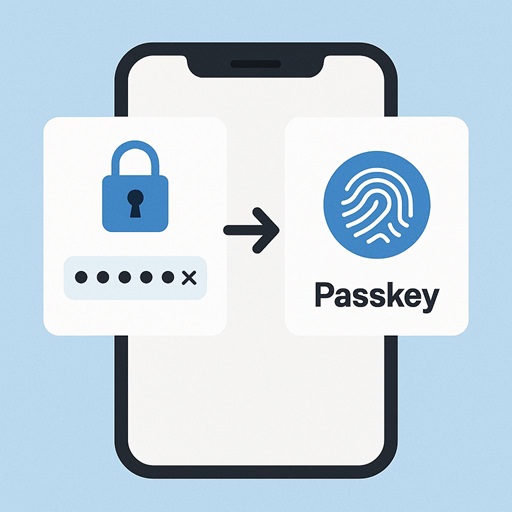The Future of Cybersecurity: Why Passkeys are Replacing Passwords in 2025
Passwords are dying. Passkeys are rising. In 2025, your device—not your memory—will protect your identity. Learn how to switch today.
For decades, passwords have been the "keys" to our digital lives. But in 2025, those keys are breaking—and hackers are exploiting the cracks. From credential theft to large-scale data breaches, weak or reused passwords still account for over 80% of cyberattacks worldwide. The truth is, passwords were never designed for today's threat landscape.
Enter the new era: passkeys—the passwordless authentication method set to replace passwords altogether. Backed by tech giants, governments, and security experts, passkeys promise a safer and simpler future. This is the new way to protect your digital identity.

🚨 The Problem with Passwords
Think about your daily logins. How many accounts have the same password or a slight variation? Maybe you've added a "1" or "!" at the end to meet complexity rules. Hackers know this game, and automation makes it easy for them to guess.
Here are the key problems:
- Password reuse: One breach means hackers can test that stolen password across all your accounts.
- Phishing: Fake login pages trick users into typing credentials, which are then harvested.
- Weak MFA: SMS-based two-factor authentication (2FA) can be bypassed with sophisticated SIM-swaps or voice phishing.
In short, passwords aren't just outdated—they're dangerous.
🔑 What Exactly is a Passkey?
At its core, a passkey is not a string of characters you need to remember. It is a cryptographic key that uses public-key cryptography, a powerful security mechanism that has been the foundation of secure online communication for decades.
When you create a passkey, your device generates a unique pair of keys:
- A Public Key: This key is sent to and stored by the website or service you are trying to access. It's safe to share and can't be used to log in on its own.
- A Private Key: This key is securely stored on your personal device (your phone, laptop, or tablet) and never leaves it. It is what allows you to prove your identity.
When you log in, your device uses the private key to sign a cryptographic challenge from the website. The website then uses your public key to verify this signature. If they match, you're in. This process is instant, secure, and completely invisible to the user.
✅ Why Passkeys Are Taking Off in 2025
This isn't just a tech buzzword. Passwordless authentication in 2025 is gaining momentum because it eliminates the weak links that make passwords vulnerable.
- Phishing is Defeated: A passkey is cryptographically tied to the legitimate website's domain. Your device simply will not offer to use your passkey on a fraudulent site, making phishing attacks impossible.
- No More Data Breaches: Since there are no passwords to steal from a company's database, a data breach cannot expose your login credentials. Even if an attacker steals the public keys from a server, they are useless without the corresponding private key on your device.
- End of Password Reuse: Each passkey is unique for every single account you create, eliminating the risk of reusing a weak password.
This is a fundamental shift from a user-based security model (remembering a password) to a device-based security model (the device proves your identity), making it the true future of cybersecurity.
⚖️ Passwords vs. MFA vs. Passkeys
| Feature | Passwords | MFA (2FA Codes) | Passkeys (2025) |
|---|---|---|---|
| Security | Weak, easily stolen | Better, but hackable | Strong, phishing-resistant |
| Usability | Frustrating to manage | Slower (codes) | Seamless, 1-tap |
| Phishing Resistance | None | Low (SMS spoofing) | High |
| Data Breach Risk | High | Medium | Extremely low |
🛠️ How to Get Started With Passkeys
The good news? You don't need to be a cybersecurity expert to use them.
- Update your devices: Ensure iOS, Android, Windows, or macOS are up to date.
- Enable passkeys: Services like Google, iCloud, and Microsoft accounts already offer the option. Look for "passkey" in your security settings.
- Use your biometrics: Set up Face ID, Touch ID, or Windows Hello for quick authentication.
- Have backup options: Store recovery methods securely (hardware keys or cloud backups).
For everyday users, this means less frustration and fewer risks of identity theft. For hackers, it means one of their biggest weapons—stolen passwords—just became obsolete.
It's time to take control of your digital security. Start using passkeys where you can, and stay ahead of the cybercriminals.
✅ Final Word
Passkeys explained are more than just a security upgrade—they're a revolution in how we protect our digital identity. If you've ever worried about a hacked account, phishing scam, or stolen password, passkeys are the answer.
For more step-by-step guides on passkeys, passwordless authentication, and smart security tips for home and business, bookmark AccessDeny.tech
 Access Deny
Access Deny